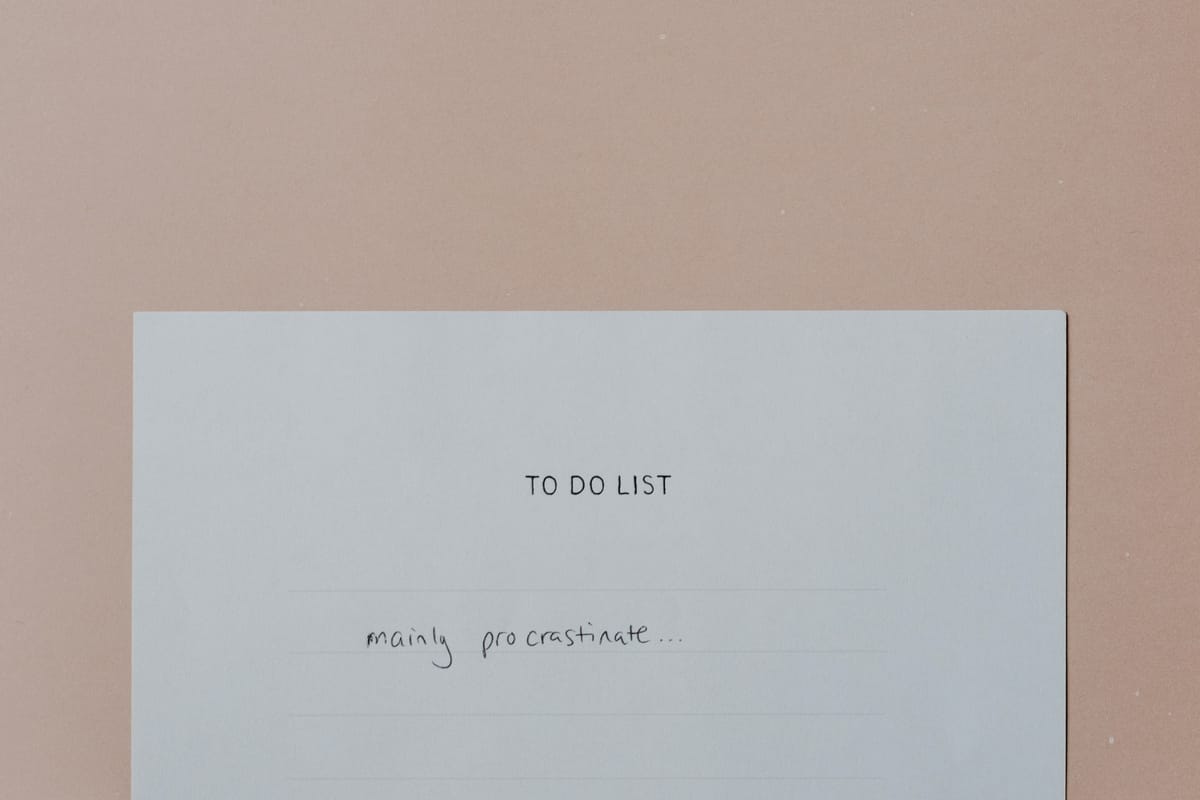No matter how driven and motivated you are as an individual, you likely struggle with procrastination. And as we’ve all transitioned to working from home over the last month or so, I can imagine that it’s become easier than ever to procrastinate.
Before I dive into the 5 things that help me avoid procrastination, it’s important to understand why people procrastinate in the first place. We never say to ourselves, “I’m never going to write the next great novel.” No, instead we say to ourselves, “I’m going to write the next great novel…tomorrow.” What makes procrastination such a toxic cycle is that we are self-aware of the harm we are inflicting onto ourselves. “When we procrastinate, we’re not only aware that we’re avoiding the task in question, but also that doing so is probably a bad idea. And yet, we do it anyway”
So, how do we manage this?
Well, at its core, procrastination is not about managing your productivity, it’s about controlling your emotions. When we procrastinate, we are effectively looking for some form of relief. Our brains are constantly looking for a better reward, something to get that next sweet release of serotonin and dopamine. “You’re going through an internal struggle. Something within you is resisting the activity you want to do, while it’s urging you toward activities you’d rather not do but that feel good.”
One of the many reasons why so many of us are more productive in an office environment than at home is because it’s a dedicated space just for work. If you look online, you’ll find a ton of articles and videos that say if you’re working from home, you should have a dedicated space that’s just for work. For some people, that’s a spare room turned home office, but for many others who may not have that luxury, their workspace can be their kitchen table, the couch, or even their bed. For me, it’s a desk that I have in my room.
But that’s not what this post is about, well, not entirely. Instead, it’s about how focusing on a routine can help get you into the right mindset and into a state of flow. For people like my parents who have always worked from home, they have a routine and it works for them. Prior to working from home, my routine included the commute to and from work, and now that that’s been removed, I’ve had to find ways to adjust.
On paper, what we need to do really couldn’t be simpler: sit down, and get to work. The best way to approach it is by asking yourself, “how do you eat an elephant?” One bite at a time, and the same applies to your daily tasks. Each incremental step adds up to something larger, and before you know it, you’re done!
However, in practice, it’s so much more difficult than it seems. So, what I wanted to focus on today are the five things that I do every day that help me to avoid procrastination and instead focus on the tasks at hand, starting with:
1. COFFEE
When I used to commute to and from the office, the first thing that I would do after setting my bag and coat down would be to walk over to the kitchenette and make myself a strong cup of coffee. There’s something about sitting down with a cup of hot coffee that signals to my brain that it’s time to work. It’s essentially a Pavlovian response; the repetition of doing the same thing every day flipped a switch in my brain and helped me to get down to the business at hand.
For you, it doesn’t need to be coffee. It could be tea, or if you’re my dad, a cup of hot water first thing in the morning to start his day. However, if you’re like me, and tend to let your coffee go cold multiple times throughout the day, then I cannot recommend the Miir mug enough.
2. TO-DO LISTS
Everyone uses some form of a to-do list, whether it’s a checklist in their notes app or a paper copy. For myself, I use a combination of the two, but I ensure that there’s a very clear distinction. Let me explain.
For my digital lists, it’s a more top-down view of the primary tasks that I want to accomplish that week. Usually, this is more broad-strokes in nature without diving into the nitty-gritty details. For my digital app, I use Google Tasks. It has great integration into both Gmail and Google Calendar but lacks any real desktop app. For that, I use a third-party web-app called TasksBoard I used to use Google Keep for both my notes, lists, and to-do items, but I find that by separating out my to-do, I’m much more focused on actually getting those done.
As for the physical, hard-copy, I’m-actually-handwriting-the-list, I stick with a basic pen and paper system. There’s something about putting pen to paper that makes things feel more immediate than if I were to type them into my phone These lists are more focused on that day’s tasks, diving into the nitty-gritty. These have tasks with subtasks - the whole gamut. In doing this, I know the 5-10 items that I need to accomplish before I can call it a day. It also helps me take a quick visual break from constantly looking at my laptop screen.
And at the end of each day, I’ll go over my list once again, and if there are any carryover items, I’ll add them to the next day’s list. This way, when I start the next morning, I already have an idea of what I need to do.
3. KEEP AN ORGANIZED DESK
There are some people in the world that are not bothered by a messy desk. In fact, they thrive in that kind of environment, and there’s a name for those people - monsters. All kidding aside, I’m the kind of person that can only operate if my workspace is neat and tidy. Everything needs to have a place and all documents need to be filed away properly.
The same applies to my digital desktops, both on my laptop and on my phone. Windows 10 is my preferred operating system, and one of the things that I love about it is that I can keep my most frequently used applications in the taskbar, and move everything else that I only use once or twice a week into the Start Menu. The other thing that I do is try to make sure that all my files are organized into their appropriate folder structure using easy to identify and remember naming schemas. These two simple things, along with my clean desk, help me to reduce the time spent wasted on searching for something, as everything has a home.
For my phone, it’s very much the same approach. I’m an Android user, so I can keep the 10 most frequently used applications on my home screen, and tuck everything else away into the app drawer. This includes things like my social media apps, games, and any other potential time waster on my device. For me, the approach of out-of-sight, out-of-mind, tends to work best, which is why aside from any incoming messages, emails, and phone calls from contacts I’ve marked as favourite, everything other notification has been disabled.
If you want to take it a step further, something that I’ve also started doing off late, you can also utilize Android’s Digital Wellbeing or iOS’ Screentime. With these two apps, you can limit the time spent using distracting apps. Once you hit the time allotment for Instagram, it will either turn the entire app monochrome to make you less enticed to use it, or they can prevent you from opening them up entirely. And if that’s not enough, try setting your phone on the other side of the room, completely out of arm’s reach. It may seem drastic, but for me, by taking these steps, I’m now genuinely more mindful of when and how I use my phone.
4. HEADPHONES
Prior to purchasing my first pair of noise-cancelling headphone last November, I was using crappy in-ear buds and on-ear headphones. I truly didn’t know what I was missing out on. Having these headphone has genuinely changed how I can focus, as it blocks out all passive sounds from my surrounding environment. This means that if my parents are having a loud conversation in the room next to me, I’m blissfully unaware. The other benefit is that when they’re on, it’s a signal to those around me that I’m focused and shouldn’t be disturbed.
The Bose QC-35 seem to be universally loved, however, I went ahead and got myself the Sony WH1000XM3. Aside from their truly terrible naming methods for almost all of their devices, Sony has a solid understanding of audio. And if you want to learn more about noise-cancellation, and how open-back headphone differ from closed-back, check out this video.
However, a great pair of headphones isn’t where this stops; you also need appropriate music. My girlfriend and I are very much the same in that we cannot listen to anything with lyrics, or else we’ll get distracted. For me, If there are lyrics, I’ll often find myself starting to type out those lyrics instead of what I should be writing. There are two Spotify playlists that I listen to: Lo-Fi Beats and Jazz Vibes. These are great because they’re simple, can fade into the background, and I don’t have to spend any energy focusing on the music or instrumentals; they all kind of just fade into each other. My girlfriend, on the other hand, listens to this on YouTube. She says that she’s been using it since her university days and seeing as she tends to have higher grades than me, it seems to be working.
5. TAKE A BREAK
As counter-intuitive as it may sound, working at a break-neck pace will tire you out, eventually even leading to burnout. As someone who’s burned out in his work environment a few times (something I didn’t want to acknowledge until my girlfriend sat me down and talked to me about it), I can tell you that it’s not fun.
By building in regular breaks into your day, whether it’s to have a quick snack or go for a short walk, you’re giving yourself a mental break. One of my old colleagues used to say that, “I’m going squirrely staring at this screen, so I’m going to step away for 10 minutes and come back with a fresh set of eyes to tackle this problem.” And sometimes, in order to maintain your productivity, that’s exactly what you need; a brief mental respite.
I find that the days I work straight through, without a break, I’m far more mentally exhausted than I am on the days that I take those short breaks. For me, I like to build those into my calendar by setting reminders at set times to stand up from my desk, stretch, and go for a short walk, and when I come back, I’m ready to get going again.
And that’s it. Those are the five things that I do (or at least try to do) on a daily basis to avoid procrastination. I’d love to tell you that it works all of the time, but I’m human, and sometimes it happens. And that’s important to remember; not to feel bad if you do procrastinate, because you’re human too.



Member discussion: